Advanced 3D Art
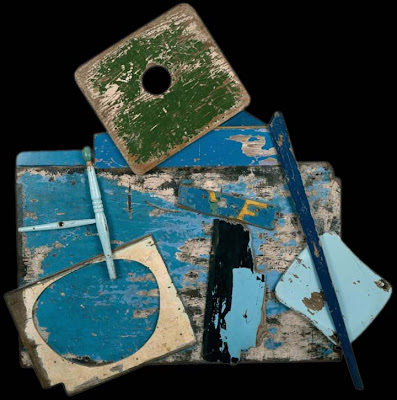
Margaret Mellis, 'F', 1997
This will be your next project. You will create an abstract relief sculpture. It will be an assemblage sculpture, made largely out of wood. Today's blog post will introduce you to this project.
Please read this blog post and look at the pictures. Then, complete today's online assignment by answering the questions below (farther down, near the bottom of this post).
(Note: you will receive an handout with specific instructions for making your sculpture.)
First, let's review some terms:
Abstract art: pictures or sculptures that may be based on actual objects, but where the objects have been simplified, stylized, distorted, or otherwise altered to the point where they may become difficult or impossible to recognize. (The term abstract art is also sometimes used to describe non-objective art-- see below.)
Non-objective art: pictures or sculptures that do not have any recognizable objects whatsoever. Non-objective art frequently focuses on things like color, shape, texture, and so forth.
Relief: sculpture that is attached to and projects outward from a wall or panel.
There are three kinds of relief sculpture— low, high, and sunken. Low relief projects only slightly from its background; high relief projects farther out from its background. Sunken relief does not project at all—instead, shapes and forms are defined by carving into the surface. Some of the earliest forms of sculpture involve carving into various surfaces made of stone.
Assemblage: a type of modern sculpture where a number of objects and/or materials are combined and "assembled" to create a work of art. Objects/materials are often "found", but materials can also be things like wood that is cut to a particular size and shape.
A few historical examples of relief sculpture
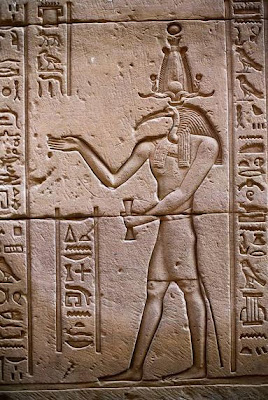
Ancient Egypt, c.1500 b.c.
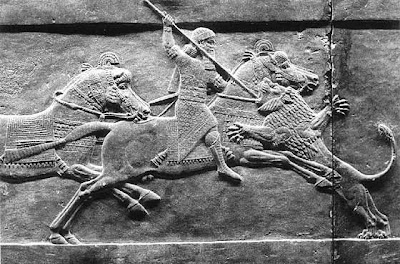
Assyrian Empire (Iraq), 665 b.c.

Ancient Greece, c.300 b.c.

Mayan (Mexico), 709 a.d.
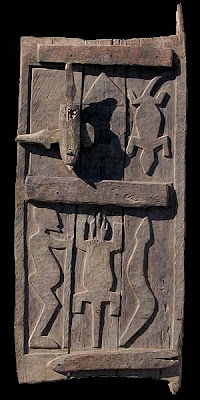
Dogon, Mali (Africa), 19th c.
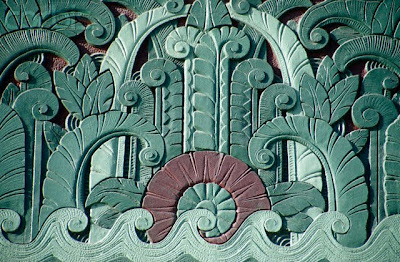
Art Deco relief on a building in Miami, FL, c.1930s
Contemporary (modern) abstract relief sculpture

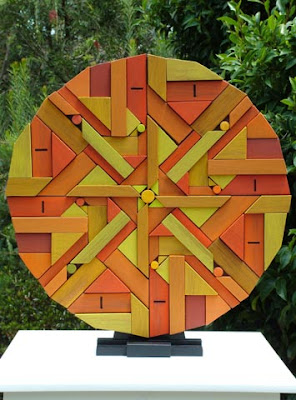
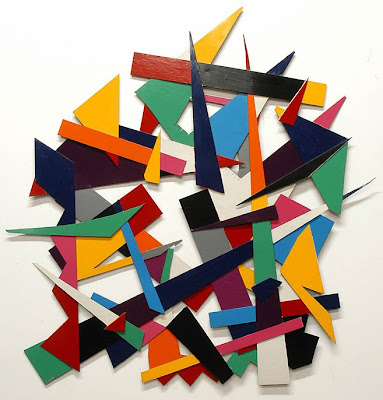
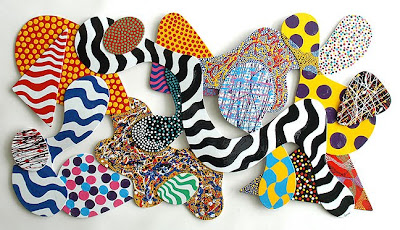

Today's online assignment: we will be focusing on the sculpture of Margaret Mellis. Go to this website, read at least the first paragraph, and look at the images. Then answer the questions below. To answer the questions, make a comment with your answers. Number your answers, and SIGN YOUR NAME if you want to receive credit!
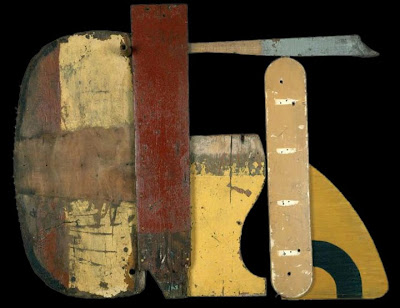
Margaret Mellis, Rust and Yellow, 1990
Questions for today:
1. What materials did Mellis use to create these sculptures? (be specific!)
2. How did she design/create these sculptures?
3. How are the pieces assembled?
4. Look at the picture titled Detail of Studio. What does this picture suggest in regards to the way she made her assemblage sculptures?
5. Select one of the sculptures by Mellis. Give its title and describe it in detail.
Next step: start thinking about what you might do for this project. Note that Margaret Mellis' sculptures are made out of "found" wood, while most of the others shown above are made out of wood that has been cut to size and shape. How might you approach this project? Where could you find some old pieces of wood?
*


19 comments:
Caitlin DeMara
1. What materials did Mellis use to create these sculptures? (be specific!)
Mellis used snapped wave-worn plywood boards; red, blue and green pieces of wood; scraps of leather and mangled rope.
2. How did she design/create these sculptures?
She designed/created tehse sculptures by arranging the different random bits into whatever was pleasing to her eye.
3. How are the pieces assembled?
The pieces were assembled with screws.
4. Look at the picture titled Detail of Studio. What does this picture suggest in regards to the way she made her assemblage sculptures?
They were not meticulously put together, they were kind of placed together as she went along.
5. Select one of the sculptures by Mellis. Give its title and describe it in detail.
Sinking Boat.
Assembled to look like a sinking ship, made with various pieces of painted and wrecked driftwood.
1. she used drift wood, plywood,bust planks and wood fillets. he aslos used rope and paints, and leathers.
2.the pices of wood were painted, and shaped, and snapped
3.she places the objects randomly and adjusted them until they looked right, then when she liked it she would skrew them in.
4.it says her style is very random and she places objects in no particular way. messy.
5."Sinking Boat 1989 driftwood" there is snapped, painted and randomly arranged pieces of wood, and being that it is called sinking boat you can actually see some form of a sail boat shape in the sculpture.
celia eddy
1. Driftwood, planks of wood, peices of wood, scraps of wood, and more wood.. and wood.
2. Randomly placed object until they "looked right."
3. Randomly.
4. She just collected stuff, and put it together.
5. Marsh Mist - Planks of wood, variying in size, shape and color, assebled with screws and probably glue. The peice itself is interesting, and would make a lovely wall decoration but I really don't think it's worth a detailed description, or intense study. It is what it is. No more. No less.
~Lindsey Burcar
KYLE SMITH
1.she found all the materials she used in the sculptures and tweeked them a little.
2.she combined the pieces she found and tweeked.
3.she screwed them into place
4.that a studio is not always clean but u can always find something beautiful(the chair)in the calamity.
5.its name is "frais" and there is a piece of sky blue wood that fades to dark blue or navy blue.Then a plank on top of that in the center that is brown and has "frais" in white letters on it.Then there is a wooden ring at the bottom that has 3/4 of it colored red and 1/4 of it colored peach or tan.The next piece is another piece of wood that is shorter than the others and it is a maron or redish color. Another piece is what looks like a fishing lure without its hooks and it is red and white striped above the red piece of wood.
1. What materials did Mellis use to create these sculptures? (be specific!)
Mellis used discarded wood.
2. How did she design/create these sculptures?
She left them as she had found them, shaped by whatever happened to them.
3. How are the pieces assembled?
She arranged them until they "looked right", then screwed them together.
4. Look at the picture titled Detail of Studio. What does this picture suggest in regards to the way she made her assemblage sculptures? Everything has its places in a certain set space in her art as well as her studio.
5. Select one of the sculptures by Mellis. Give its title and describe it in detail.
'Whip'. by Mellis is interesting in the way it's titled because it could be many things. It could be a fishing pole,which is what i first thought of when I saw it.
Tachae
1) She used old pieces of wood that may have once been part of a ship destroyed at sea.
2) She didn't do any designing. She use dthe pieces as she found the and placed them as she felt they hsoud be placed.
3)She would arrange and rearrange things until they "looked right".
4)It suggests they she just kind of threw stuff together with no real original intent.
5) Nine 1980 driftwood construction an old worn peice of circular wood with more peices of old worn semi painted wood nailed to it.
-Nina
kurt brush
1. looks like pieces of wood pulled out of the garbage and from benches.
2.she looked for certain pieces to create that sculpture.
3.well they could be glued together or they are laying on the ground.
4.she worked hard on it. 5. Rust and Yellow, wood pieces pulled out of the garbage and pieces laying around, and broken furture.
joe humphreys / second hour
1. What materials did Mellis use to create these sculptures? (be specific!)
Mellis made her sculptures out of driftwood, plywood- often broken or snapped into fragments. The pieces she found are already painted.
2. How did she design/create these sculptures?
Mellis spent time arranging and rearranging the pieces of driftwood until she found a placement she liked.
3. How are the pieces assembled?
The pieces are screwed and glued into place once she finds a design she likes.
4. Look at the picture titled Detail of Studio. What does this picture suggest in regards to the way she made her assemblage sculptures?
Mellis had shelves of found driftwood at which she could pick out pieces to use in her sculptures.
5. Select one of the sculptures by Mellis. Give its title and describe it in detail.
Sinking Boat - 1989
The way the pieces are made represent a boat as it's sinking. The pieces of blue wood reperesent the water as it overtakes the boat. The blue triangle is reminiscent of a sail shaped boat.
Kayla Friess
1. Driftwood, planks, an assortment of jetsam, mangled rope, bowls, etc.
2. She moved them around until it "looked right". I wish I were capable of such things.
3. Glue, paint, and screws.
4. She constructed them in a messy workroom, with a lot of wood at hand. She used tools. She sat in a chair. With a workbench in front of her. Covered in stuff.
5. In the sculpture, Nine, she took random pieces of wood and attached them to a wooden circle. On top of one of these wooden boards, there is another horseshoe shaped piece of wood. Each piece of wood has a flakey dabbled paint job.
1. wave-worn plywood boards untidily snapped like indigestible wafers, bust planks and wooden fillets that had once been painted red, blue or green for some purpose now impossible to ascertain.
2. She didnt design them, she just aranged them in the condition they were all ready in.
3. she used many influences such as, friends and relationships with people around her.
4. honestly it seems lazy but it seems to show her ramdomness with feelings and her imagination.
5."detail of studio" the piece consist of a chair, picture frame and several stacks of wood increasing in length from the bottom up.
THE REAL ANTHONY B.
1. She used pieces of driftwood which were plywood boards snapped like wafers, planks, and wooden fillets that were once painted green, blue, or red.
2. She designed these sculptures by arranging and rearranging objects until they "looked right".
3. The pieces were assembled by being screwed into place.
4. The picture titled Detail of Studio suggest that she made her assemblage sculptures by just placing objects in places where they looked good.
5. Her sculpture, White Relief, was made by placing white painted pieces of wood in the shape of a diamond on a piece of wood shaped like an octagon.
Rebecca Reichenbach
Alexandra Kosut
1)What materials did Mellis use to create these sculptures? (be specific!)
Margaret Mellis used pieces of driftwood, wave-worn plywood boards, bust planks, wooden fillets, and mangled rope.
2)How did she design/create these sculptures?
She randomly placed objects and put them together.
3) How are the pieces assembled?
She would screw the pieces into place.
4)Look at the picture titled Detail of Studio. What does this picture suggest in regards to the way she made her assemblage sculptures?
She collected items and then placed the objects randomly.
5)Select one of the sculptures by Mellis. Give its title and describe it in detail.
Sinking Boat 1989. This art piece is assembled to look like a sinking boat. You can tell its a boat because the blue triangle looks like a sail. This art piece is made out of driftwood. You would find driftwood after a boat sinking.
Shannon Vorus
1. What materials did Mellis use to create these sculptures? (be specific!)
Mellis used snapped wave-worn plywood boards; red, green and blue pieces of wood; scraps of mangled rope and leather.
2. How did she design/create these sculptures?
She designed/created these sculptures by arranging the different random pars until she found something that pleased her.
3. How are the pieces assembled?
The pieces were assembled with screws.
4. Look at the picture titled Detail of Studio. What does this picture suggest in regards to the way she made her assemblage sculptures?
They were like placed together as she went along it wasnt like all of it was put together from the get go.
5. Select one of the sculptures by Mellis. Give its title and describe it in detail.
Sinking Boat.
It is assembled to look like a sinking ship, made with different pieces of painted and wrecked driftwood.
bianca
1. The materials she used was planks, drift wood,wood fillets, plywood, leather, rope and paints.
2.The pieces of wood were snapped, painted, and moved around until it had the image she was looking for.
3. She moved them around randomly and adjusted them until they looked like she wanted them to. She glued, painted, and screwed.
4.Her style is random and placed objects in no specific order.
5.Nine...She took random wood pieces from all shapes and sizes and made a circle like dabbed with paint. One of the pieces of woods look like a U or a horseshoe kindof shape.
1. What materials did Mellis use to create these sculptures? (be specific!)
Mellis used snapped wave-worn plywood boards; red, blue and green pieces of wood; scraps of leather and mangled rope.
2. How did she design/create these sculptures?
She designed/created these sculptures by arranging the different random bits into whatever was pleasing to her eye.
3. How are the pieces assembled?
They were assembled with screws.
4. Look at the picture titled Detail of Studio. What does this picture suggest in regards to the way she made her assemblage sculptures?
They were not put together, they were kind of placed together as she went along.
5. Select one of the sculptures by Mellis. Give its title and describe it in detail.
Sinking Boat.
Assembled to look like a sinking ship, made with various pieces of painted and wrecked driftwood.
christopher rudko
1. What materials did Mellis use to create these sculptures? (Be specific!)
Margaret Mellis used driftwood mostly, sometimes the wood was painted on with oil paints, she also used paper cut into different shapes and arranged to look interesting. But most of her sculptures are driftwood constructions.
2. How did she design/create these sculptures?
She would play around, moving and arranging her found objects until she thought it looked right, and then bolted them together.
3. How are the pieces assembled?
At first glance they seemed totally jumbled around in no specific order, but look closer and you can see what it's actually meant to be, like one of her Assemblages which is a city skyline, just looks like a bunch of wood nailed together.
4. Detail of Studio suggests that she had a unorganized studio.
5. Rising Deep 2001 driftwood construction 116 x 55 x 10cm: Made out of many long pieces of wood, some longer then others. This sculpture has been painted on and the wood arranged parallel and very close to one another.
Madeline Toro
1. She used wood that was found anywhere. She also used drift wood. She painted them many different colors.
2. She would move and switch the peices of wood untill she decided they looked right.
3. She would screw or glue the wood together.
4. Her work place seemed to be a bit clutered and what not so I think thats where she gets her ideas.
5. Marine City driftwood construction 64.8 x 64.8 x 7cm
This sculpture is painted bright colors and has a cool little fish. It reminds me of a lake or water.
The one above is from Emma Jeffrey
Post a Comment